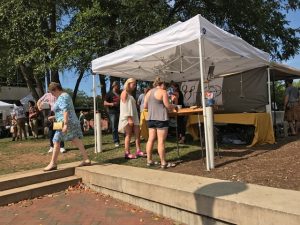What DIY?
As I started writing for DIYabled, I was getting asked by a lot of folks what is DIY? The acronym stands for Do It Yourself and while a DIY movement has a lot of history, the term itself can really refer to anything from remodeling homes to fixing your own bike. When I talk about it, I am referring to the DIY ethic that has existed in the underground music scene. It was an ethos that had its beginnings in the 1970s as a way for bands to bypass the corporate mainstream industry by, you guessed it, Doing It Yourself. Over the last 50 years, this DIY ethos has grown from the art/punk music scene to what we see today. All genres, from intimate folk shows to electronic dance parties to experimental music, have turned to the DIY ethos as a means to develop an opportunity to make music and play for the people who helped create it.
Why DIY?
I was fortunate to part of a group of folks in the 90s that worked together to set up an infrastructure for bands to tour, put out records and actually play their music for an audience! We lived in the south and wanted to play our music and share our art there and beyond. We did not fit into the mainstream at the time so we created our own spaces: houses, basements, even the outdoors. No places were off limits. With a generator and some speakers a show could be created just about anywhere. It was a community we created ourselves for ourselves. DIY is about community. And without a community, we are alone.
Why think about accessibility?
People Living with Disabilities (PLD) make up the largest minority in the world. It’s been reported that there were about 57 million PLD in 2010 in the U.S. alone. As a community, if you are not thinking about accessibility, you are excluding a huge group of people. Any group of individuals that understands the true meaning of the DIY ethic also understands that without it, this minority could not live. Because most people I meet have no idea what accessibility means exactly, I decided to make this zine to give some tips about DIY accessibility.
How to know or make your space is accessible?
Due to the nature of DIY, accessibility is a huge issue. But this does not mean that you can’t try to make your space PLD friendly if not completely PLD accessible. What that means is PLD can get in and out of a space to enjoy an event, even if they may not be able to use the bathroom or parts of your space are not completely accessible.
The space. Wide open spaces with with no obstacles like record shelves or garbage cans in the way.
The entrance. If it is completely ground level, perfect. If there are stairs, build a ramp. There are lots of DIY wheelchair ramp tutorials on YouTube. The ADA requires a ramp ratio of 1:20, so for every inch of height, you need 20 inches of length for the ramp. A step that is 3 inches would require 5 feet or 60 inches of ramp. This is not always possible to do with the amount of space available so if you have to, just make a steeper ramp. Do it! Having a ramp will allow any person in a wheelchair to access your space. If it is too steep you can always use our greatest resource, humans, to help push the wheelchair up the ramp.
Doors. The ADA requires door widths to be at least 32 inches. If your door width is a bit smaller, that is fine because that width is for an average wheelchair to fit through the doors. Some people have wheelchairs that are smaller than 32 inches and some that are larger.
Bathrooms. The biggest challenge. ADA has specifics and from my experiences, DIY spaces rarely have accessible bathrooms. A door that is actually wide enough is required but if the wheelchair can actually get in and the person can get to the toilet, having grab bar would help. You can purchase them at your local hardware store and they’re really cheap!
In reality every space cannot be accessible. When a space is having an event, informing people in advance about whether or not they can get in is another way to include the people of your community. An easy way to do this is displaying an accessible symbol if your space is PLD accessible. This is a symbol saying that you are PLD friendly, please contact for specifics. You can also put up an accessible symbol with a line through it if your space is completely inaccessible. Disability comes in so many shapes and sizes that you should always offer contact information so if PLD are intrested they can make 100% sure they can get in. These small gestures of consideration are important because there is nothing more heartbreaking than watching all of your able bodied peers walk into an inaccessible space.
Like this ? Then


